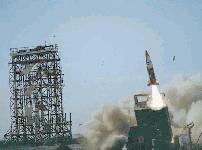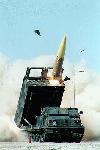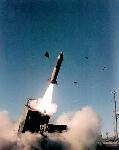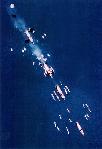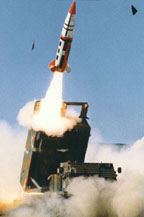
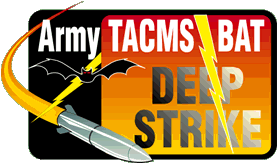 The Army Tactical Missile System (Army TACMS) is a family of long-range, near
all-weather guided missiles fired from the Multiple Launch Rocket System (MLRS)
M270 launcher and deployed within the ammunition loads of corps MLRS battalions.
The Army TACMS provides the joint task force (JTF) and corps commanders an
operational fires capability for precision engagement of the enemy throughout the
depth of the battlefield beyond the range of currently fielded cannons and rockets. It
delays disrupts, neutralizes or destroys high payoff targets such as combat maneuver
units, surface to surface missile units, air defense units, command/control/
communications sites and helicopter forward area rearming/refueling points. The
Block IA is an upgrade intended to double the range of the current Army TACMS
Block I missile. Army TACMS Block IA will dispense M74 Anti-Personnel,
Anti-Materiel (APAM) bomblets, as does the Block I. The Army TACMS Block
IA's ability to engage the enemy at extended ranges will reinforce the dominant
maneuver force by helping the JTF commander shape the battlespace.
Army ACAT IC Program
The Army Tactical Missile System (Army TACMS) is a family of long-range, near
all-weather guided missiles fired from the Multiple Launch Rocket System (MLRS)
M270 launcher and deployed within the ammunition loads of corps MLRS battalions.
The Army TACMS provides the joint task force (JTF) and corps commanders an
operational fires capability for precision engagement of the enemy throughout the
depth of the battlefield beyond the range of currently fielded cannons and rockets. It
delays disrupts, neutralizes or destroys high payoff targets such as combat maneuver
units, surface to surface missile units, air defense units, command/control/
communications sites and helicopter forward area rearming/refueling points. The
Block IA is an upgrade intended to double the range of the current Army TACMS
Block I missile. Army TACMS Block IA will dispense M74 Anti-Personnel,
Anti-Materiel (APAM) bomblets, as does the Block I. The Army TACMS Block
IA's ability to engage the enemy at extended ranges will reinforce the dominant
maneuver force by helping the JTF commander shape the battlespace.
Army ACAT IC Program800 systems
Total program cost (TY$) $658.6M
Average unit cost (TY$) $0.82M
Full-rate Production 2QFY98
Prime Contractor
Lockheed Martin Vought Systems
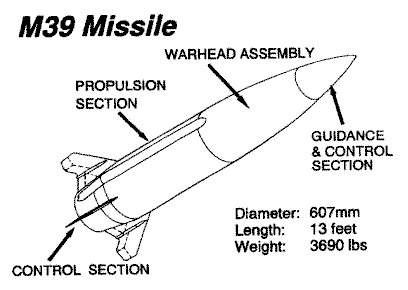
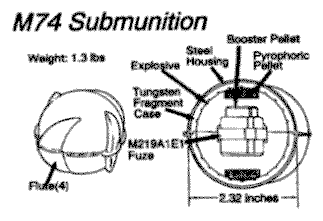 The M39 Missile Warhead is used against personnel and soft targets normally with a TLE of 150 m or less. Larger TLEs may reduce effectiveness. Each missile dispenses a cargo of approximately 950 antipersonnel and antimateriel (APAM)
M74 grenades over the target area. Warhead event is initiated by an electronic time fuze (M219A2) that is set in the same manner as the M445 electronic time fuze of the M26 rocket. The fuze detonates shaped charges mounted to the skin and bulkheads. This in turn severs the skin. By means of centrifugal force and airstream currents, the M74 grenades are distributed over the target area. Arming of the M74 grenades is accomplished by the spin action which is induced on the individual grenade. The M74 grenade is filled with composition B explosive filler and is covered by a
steel shell. Upon impact and detonation each grenade breaks up into a large number of high-velocity steel fragments that are effective against targets such as truck tires, missile rounds, thin-skinned vehicles, and radar antennas. This submunition is not effective against armored vehicles. The M74 grenade also contains incendiary
material and has an antipersonnel radius of 15 m.
The M39 Missile Warhead is used against personnel and soft targets normally with a TLE of 150 m or less. Larger TLEs may reduce effectiveness. Each missile dispenses a cargo of approximately 950 antipersonnel and antimateriel (APAM)
M74 grenades over the target area. Warhead event is initiated by an electronic time fuze (M219A2) that is set in the same manner as the M445 electronic time fuze of the M26 rocket. The fuze detonates shaped charges mounted to the skin and bulkheads. This in turn severs the skin. By means of centrifugal force and airstream currents, the M74 grenades are distributed over the target area. Arming of the M74 grenades is accomplished by the spin action which is induced on the individual grenade. The M74 grenade is filled with composition B explosive filler and is covered by a
steel shell. Upon impact and detonation each grenade breaks up into a large number of high-velocity steel fragments that are effective against targets such as truck tires, missile rounds, thin-skinned vehicles, and radar antennas. This submunition is not effective against armored vehicles. The M74 grenade also contains incendiary
material and has an antipersonnel radius of 15 m.
Army TACMS Block I:
SYSTEM DESCRIPTION:The Army Tactical Missile System (Army TACMS) resulted from a need to engage high priority targets at ranges beyond those of existing weapons. The Army TACMS Block I replaces the conventional Lance system. Block I is a ground launched, deep fires missile system consisting of a surface-to-surface guided missile with an anti-personnel/anti-materiel (APAM) warhead consisting of approximately 950 M-74 bomblets. The missiles are fired from the Multiple Launch Rocket System (MLRS) modified M270 launcher. The missiles are deployed within the ammunition loads of corps MLRS battalions and/or division artillery batteries. The Army TACMS includes guided missile and launching assembly, test set, guided missile system, training set, guided missile system: M165, trainer, test device guided missile: M70, modified M270 launcher, and Army TACMS missiles facilities. SYSTEM CHARACTERISTICS:
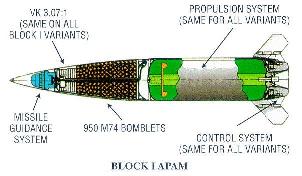 The Army TACMS Block I is a semi-ballistic missile with an APAM
warhead that contains approximately 930 M-74 bomblets. There is
1 missile per guided missile and launching assembly and 2 missiles
per launcher load. The missile will engage targets throughout
the corps area of influence and is designed to destroy tactical
missile launchers, suppress air defense, counter Command, Control,
and Communications (C3) complexes and disrupt logistics.
The Army TACMS Block I is a semi-ballistic missile with an APAM
warhead that contains approximately 930 M-74 bomblets. There is
1 missile per guided missile and launching assembly and 2 missiles
per launcher load. The missile will engage targets throughout
the corps area of influence and is designed to destroy tactical
missile launchers, suppress air defense, counter Command, Control,
and Communications (C3) complexes and disrupt logistics.MISSION:
Provides deep fires in support of deep attack/precision strike operations.
Target Set: 2nd Echelon Maneuver Units; Air Defense Units; Command and Control Sites; Surface-to-Surface Missile Units; Forward Area Refueling
Resupply Points (FARRPS). The Army TACMS Block I missile underwent IOT&E in 1990. The most significant deficiency noted in the DOT&E BLRIP report that followed the IOT&E was that the Army did not demonstrate the ability to conduct target acquisition at the Block I engagement ranges. However, DOT&E assessed the system to be operationally effective, and the system entered full-rate production. Army TACMS Block I was deployed and fired in Operation Desert Storm.
Army TACMS Block IA
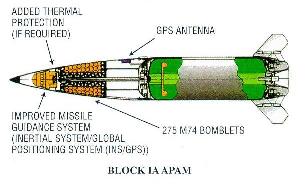 SYSTEM DESCRIPTION:
SYSTEM DESCRIPTION:Army TACMS Block IA is an extended range variant of the Army TACMS Block I missile. The Block IA effort entails integrating an onboard Global Positioning System (GPS) with antenna and software into an inertial navigation system and reducing the Block I payload from 950 M-74 bomblets to approximately 300 M-74 bomblets to achieve the required accuracy and extended range. To compensate for the reduced payload, the accuracy of the missile has been improved with inflight GPS updates. If GPS is rendered inoperable, the Army TACMS Block IA reverts to inertial guidance only and maintains Block I accuracy. The missile is fired from the Improved Position Determining System of the M270 "deep strike" launcher and the M270A1 launcher with the improved fire control system (IFCS) and improved launcher mechanical system (ILMS). SYSTEM CHARACTERISTICS:
Army TACMS Block IA is a semi-ballistic missile that provides near all weather, day and night, precision strike capability at ranges beyond existing cannons, rockets, and missiles. Block IA uses the guided missile control and propulsion systems of the Army TACMS Block I missile. The Block IA warhead will use a majority of the Block I warhead components except the payload of anti-personnel/anti-materiel (APAM) M-74 bomblets will be reduced in the Block IA to extend its range. Block IA uses an improved version of the Army TACMS Block I Missile Guidance Set (IMGS) to achieve the improved accuracy needed to meet the Block IA system requirements for mission accuracy. The IMGS uses an embedded GPS receiver (EGR) to receive and process GPS satellite navigation signals and integrate the GPS data into the inertial guidance scheme to improve navigational accuracy. There is 1 missile per guided missile and launching assembly and 2 missiles per launcher load. DEVELOPMENT ACTIVITIES
Prior to completion of the MLRS Improved Fire Control System (IFCS), the M270 launcher requires modifications that include the installation of an interim improved positioning and determining system (IPDS) and an interface for connecting a KYK-13 cryptographic loading device. The IPDS, the positioning and navigation unit of the future IFCS, employs ring laser gyros, force-rebalanced accelerometers, and the GPS to provide launcher location and navigation data. The Army will field one battalion of IPDS-equipped launchers until IFCS is fielded in the M270A1 launcher program. In April 1996, the PEO Tactical Missiles conducted a Low-Rate Initial Production (LRIP) review of the program and authorized procurement of 70 Block IA missiles. The Army conducted three missile launches prior to the LRIP review, and five additional missile firings in the formal developmental testing between February and October 1996. The IOT&E, consisting of a ground phase at Fort Sill, Oklahoma, and a two-missile live firing phase at White Sands Missile Range, New Mexico, was conducted in August and September 1996. Live Fire testing, consisting of an arena test (22 M74 bomblet firings) and two end-to-end missile firings (one DT shot against a 9-target array and one OT shot against a 15-target array), was completed in September 1996. During 2QFY97, DOT&E completed its assessment of the Army TACMS Block IA and participated in the Integrated Product Team preparations for a March 1997 Army Systems Acquisition Review Council Milestone III decision. Problems identified in the Army's and DOT&E's assessments caused the Army Acquisition Executive (AAE) to delay the Milestone III decision until 2QFY98, and grant approval for a second LRIP contract award for 97 missiles. The Army Training and Doctrine Command (TRADOC) is coordinating a sensor-to-shooter assessment to determine the Army's capabilities to detect targets at the Block IA ranges and to process that information in a timely manner. They have established a General Officer Steering Committee to monitor progress of the assessment. The GOSC includes the Deputy Under Secretary of the Army for Operations Research; the Assistant Deputy Chief of Staff for Operations–Force Development; The Deputy for Systems Management; the Program Executive Officer (PEO) Tactical Missiles; PEO, Intelligence and Electronic Warfare; Commandant, U.S. Army Field Artillery School; Commandant, U.S. Army Intelligence Center; and Commanding General, U.S. Army Operational Test and Evaluation Command. Program Manager (PM), Army TACMS, is sponsoring an excursion to a Joint Staff study of Joint Suppression of Enemy Air Defenses (JSEAD) in a Southwest Asia scenario. The excursion is intended to demonstrate the inflight survivability of the Block IA in an active threat air defense environment. If necessary, TRADOC will update the Cost and Operational Effectiveness Analysis based on the study's determination of missile survivability. PM, Army TACMS, sponsored additional live fire testing to improve characterization of M74 bomblet effects against the threat targets. Those tests include employment of a live warhead against trucks and fuel containers, and arena testing to characterize bomblet pyrophoric effects against targets configured with fuel and ammunition. After analysis of the IOT&E, LFT&E and flight test data which were generated in accordance with the approved TEMP, DOT&E assessed the Army TACMS Block IA to be not operationally effective, and not operationally suitable as tested. The DOT&E assessment was based on deficiencies in the target acquisition system at Block IA ranges, missile performance, bomblet lethality, missile inflight survivability and reliability. The Army's conclusion was that ATACMS Block IA was suitable and marginally effective. The AAE's Acquisition Decision Memorandum (ADM) stated that a favorable decision at the Milestone III will be contingent on addressing the following issues.
- Using Joint Command, Control, Communications, Computers, Intelligence, Surveillance and Reconnaissance (C4ISR) architecture, can the Army consistently demonstrate the ability to detect and locate targets with the required accuracy at the extended range of the Block IA system, and then provide the targeting data to the Deep Operations Coordination Cell in a timely manner?
- Can the Army demonstrate the ability to achieve the required level of effects on all of the Block IA Operational Requirements Document (ORD) targets?
- Can the Army demonstrate, through modeling, inflight survivability when attacking the ORD targets in a realistic operational scenario?
- Can the overall missile reliability (inflight and prelaunch), and launcher reliability requirements of the Army TACMS Block IA system be achieved during the life of the system?
Army TACMS Block II
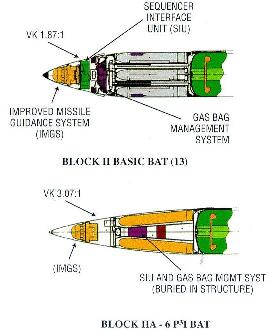 SYSTEM DESCRIPTION:
SYSTEM DESCRIPTION:The Block II Army Tactical Missile System for the Army is a long range, all weather, day/night, tactical missile designed to defeat critical high pay-off targets in support of Corps level deep operations. The Block II variant is a pre-planned product improvement (P3I) to the Army TACMS Block I and IA missile systems specifically designed to kill moving armored targets and surface-to-surface missile (SSM) transporter erector launchers (SCUD TELs). The Block II carries 13 BAT or P3I BAT brilliant submunitions. The Block II carrying the basic BAT is designed to destroy critical moving armored formations such as a reserve tank battalion moving from assembly areas in the enemy's rear. The Block II equipped with P3I is designed to seek out and destroy both stationary targets, such as the SCUD and moving TELs and tanks as well. As with the Block IA missile, the Block II guidance set is augmented by an on-board GPS to improve accuracy. SYSTEM CHARACTERISTICS:
Army TACMS Block II is a conventional semi-ballistic surface-to-surface designed to attack targets beyond the range of existing field artillery cannon and rocket fires. The missile is fired from the launcher assigned to MLRS Corps Artillery Unit. There is 1 missile per guided missile and launching assembly and 2 missiles per launcher load. The Block II utilizes the Block I missile control and propulsion set, the Block IA guidance and inertial navigation set, and unique hardware and software to assure necessary missile communication with the BAT and P3I BAT submunition. Thrust for the missile is provided by a solid propellant rocket motor which is ignited by an igniter arm/fire device. Control of the missile during flight is accomplished by four fins located 90' apart in the control section of the missile.




